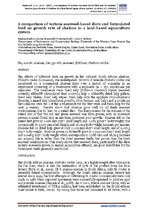| dc.contributor.author | Naidoo, Krishni | |
| dc.contributor.author | Maneveldt, Gavin | |
| dc.contributor.author | Ruck, Kevin | |
| dc.contributor.author | Bolton, John J. | |
| dc.date.accessioned | 2013-10-28T18:59:29Z | |
| dc.date.available | 2013-10-28T18:59:29Z | |
| dc.date.issued | 2007 | |
| dc.identifier.citation | Maneveld, G.W., et al . (2007). A comparison of various seaweed-based diets and formulated feed on growth rate of abalone in a land-based aquaculture system. Journal of Applied Phycology, 18: 437-443 | en_US |
| dc.identifier.issn | 0921-8971 | |
| dc.identifier.uri | http://hdl.handle.net/10566/779 | |
| dc.description.abstract | The effects of different diets on growth in the cultured South African abalone, Haliotis midae (Linnaeus), was investigated. Growth of juvenile Haliotis midae was monitored on a commercial abalone farm over a period of 9-months in an experiment consisting of 9 treatments with 4 replicates (n = 250 individuals per replicate). The treatments were: fresh kelp (Ecklonia maxima) blades (seaweed control); Abfeed® (formulated feed control); kelp + Abfeed®; dried kelp pellets; dried kelp blades; dried kelp stipes; fresh kelp with the epiphyte Carpoblepharis flaccida; a mixed diet (Gracilaria gracilis, Ulva lactuca, and kelp) and a rotational diet (abalone were fed 1 of the 9 treatments for the first week and them kelp for the next 3 weeks). Results show that abalone grow well on all fresh seaweed combinations, but do best on a mixed diet. The likely reason for the success of the mixed diet is that the red and green seaweed was farm grown, with an increased protein content. Dried kelp in any form produced poor growth. Abalone fed on the mixed diet grew at 0.066 mm day־¹ shell length and 0.074 g day־¹ body weight; this corresponds to 24.09 mm shell length and 27.01 g body weight increase per annum. Abalone fed on dried kelp grew at only 0.029 mm day־¹ shell length and of 0.021 g day־¹ body weight. Abalone grown on Abfeed® grew at 0.049 mm day־¹ shell length and 0.046 g day־¹ body weight which corresponds to 17.88 mm and 16.79 g increase per annum; this is better than the dried seaweed feeds, but poorer than the fresh seaweed combinations. This study shows that seaweed diets, particularly if the diets include seaweeds grown in animal aquaculture effluent, are good substitutes for the formulated feeds generally used today. | en_US |
| dc.language.iso | en | en_US |
| dc.publisher | Springer | en_US |
| dc.rights | This is the author postprint version of an article by Springer. The file may be freely used, provided that acknowledgement of the source is given. | |
| dc.source.uri | http://dx.doi.org/10.1007/s10811-006-9045-7 | |
| dc.subject | Abalone | en_US |
| dc.subject | Diet | en_US |
| dc.subject | Growth | en_US |
| dc.subject | Seaweed | en_US |
| dc.subject | Ecklonia | en_US |
| dc.subject | Haliotis midae | en_US |
| dc.title | A comparison of various seaweed-based diets and formulated feed on growth rate of abalone in a land-based aquaculture system | en_US |
| dc.type | Article | en_US |
| dc.privacy.showsubmitter | false | |
| dc.status.ispeerreviewed | true | |
| dc.description.accreditation | Web of Science | en_US |

